The Japan canned pasta demand is valued at USD 217.6 million in 2025 and is projected to reach USD 303.2 million by 2035, reflecting a CAGR of 3.4%. Consumption is shaped by steady use of ready-to-eat meal options among working households, students, and individuals seeking low-preparation foods. Growth is supported by increased reliance on ambient packaged meals, wider retail availability, and continued product development focused on flavour, portion convenience, and longer shelf stability. Rising adoption of emergency-preparedness food supplies also contributes to recurring demand across households and institutions.
Spaghetti-based canned pasta leads product utilization due to its familiarity, consistent texture retention after processing, and strong placement across supermarkets, convenience stores, and bulk-supply outlets. Product preference is also influenced by stable seasoning profiles and suitability for single-serve packaging formats.
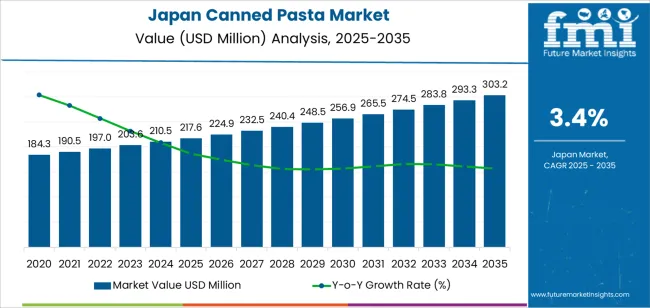
Kyushu & Okinawa, Kanto, and Kansai record the highest consumption volumes. These regions maintain dense retail networks, high urban household concentration, and robust distribution channels for shelf-stable packaged foods. Institutional procurement for dormitories, workplace canteens, and emergency-supply programmes further strengthens regional uptake. Key suppliers include House Foods Group Inc., Nisshin Foods Holdings Co., Ltd., S&B Foods Inc., Kokubu Group Corp., and Costco Wholesale Japan. These companies offer spaghetti-based canned meals, mixed pasta variants, and private-label products supplied through retail, wholesale, and bulk-distribution channels.
Growth contribution in Japan’s canned-pasta segment is shaped by steady demand across household consumption, convenience retail, and institutional food-service channels. The largest contribution comes from convenience-oriented purchasing behaviour, as canned meals fit well within Japan’s time-compressed urban lifestyles. This steady baseline supports predictable annual growth and forms the core of the contribution index.
A second contribution comes from product standardization and long-shelf-life attributes. These characteristics support stable procurement among retailers, vending operators, and emergency-supply distributors. The uniformity of supply chains and consistent stocking patterns reinforce incremental year-to-year gains without producing sharp swings.
An additional contribution arises from gradual diversification of flavour profiles and portion formats. Although innovation in this category remains modest, periodic reformulations and extended product lines support controlled incremental uptake among younger consumers and single-person households. Institutional demand from schools, dormitories, and workplace cafeterias adds a minor but stable contribution tied to procurement cycles.
| Metric | Value |
|---|---|
| Japan Canned Pasta Sales Value (2025) | USD 217.6 million |
| Japan Canned Pasta Forecast Value (2035) | USD 303.2 million |
| Japan Canned Pasta Forecast CAGR (2025-2035) | 3.4% |
Demand for canned pasta in Japan is increasing because households seek convenient, shelf-stable meal options that fit busy schedules and limited kitchen space. Canned pasta offers quick preparation and long storage life, which appeals to single-person households and working adults who prefer simple meals without extensive cooking. Retailers promote canned meals as part of ready-to-eat food sections, and this encourages repeat purchases among consumers who value portability and portion control. Emergency preparedness habits in Japan also support steady demand because canned foods are commonly stored for disaster readiness.
Manufacturers introduce more flavour variations and Japanese-style adaptations that match local taste preferences, which broadens acceptance across age groups. Convenience stores and online grocery platforms further increase visibility and accessibility. Constraints include strong competition from chilled and frozen pasta meals that offer fresher texture, as well as rising interest in healthier or premium meal options that may reduce reliance on canned formats. Some consumers prefer fresh ingredients and limit canned food consumption due to concerns about taste or sodium content.
Demand for canned pasta in Japan reflects consumption patterns shaped by convenience needs, shelf-stable meal preferences, and the availability of varied pasta formats suited to domestic cooking habits. Product type selection varies by texture preferences, serving size requirements, and compatibility with sauces commonly used in Japanese households. Source distribution shows how wheat-based and alternative-grain pastas support dietary preferences and allergen-sensitive consumers. Distribution channels illustrate how Japanese shoppers obtain canned pasta across large retail formats, e-commerce platforms, and smaller neighborhood stores. These patterns highlight how shelf-stable pasta products support meal planning, emergency stockpiling, and convenience-driven food purchasing across different household structures in Japan.
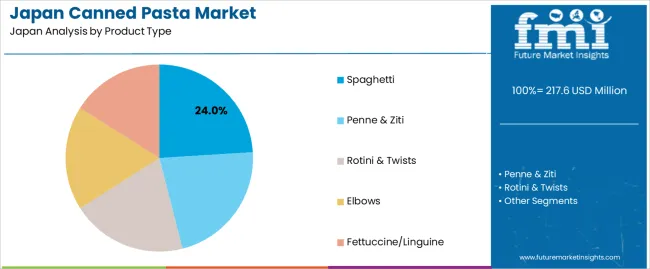
Spaghetti holds 24.0% of national demand and represents the leading canned pasta type in Japan. Its familiarity, versatility, and compatibility with common sauces make it a preferred option for households seeking quick meals. Penne and ziti account for 22.0%, supporting consumers who prefer firmer textures and shapes suited to thicker sauces. Rotini and twists represent 20.0%, used in pasta salads and mixed preparations. Elbows hold 18.0%, fitting child-friendly meals and compact serving formats. Fettuccine and linguine account for 16.0%, used in creamy or specialty dishes. Product-type distribution reflects Japan’s varied consumption patterns across traditional pasta shapes adapted to local meal preferences and convenience-driven use.
Key points:

Wheat accounts for 38.0% of national demand and remains the dominant source used in canned pasta across Japan. Its processing characteristics support stable texture, consistent hydration, and widespread consumer familiarity. Rice-based pasta holds 26.0%, serving consumers requiring gluten-free or lighter-texture alternatives. Buckwheat represents 20.0%, used in niche canned pasta products that incorporate Japanese grain preferences. Oats account for 16.0%, supporting specialty formulations aimed at fiber-rich or alternative-grain meal options. Source distribution reflects Japan’s combination of Western pasta habits and regional dietary trends that include alternative grains for health, allergen, or preference-based consumption.
Key points:
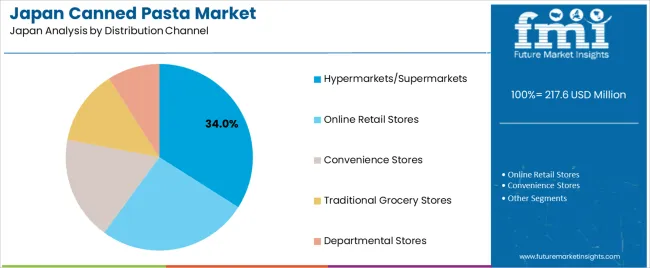
Hypermarkets and supermarkets hold 34.0% of national demand and represent the leading distribution channel for canned pasta in Japan. These stores provide broad product visibility, competitive pricing, and regular restocking, supporting routine household purchasing. Online retail stores account for 26.0%, driven by convenience, subscription purchases, and diversified product listings. Convenience stores represent 18.0%, supporting immediate meal needs and compact household shopping patterns. Traditional grocery stores hold 13.0%, serving neighborhood-based shoppers. Departmental stores account for 9.0%, offering specialty or imported canned pasta varieties. Channel distribution reflects Japan’s retail structure combining large chains, e-commerce growth, and frequent small-format shopping.
Key points:
Growth of emergency-preparedness stocking, increased reliance on quick meals among single-person households and rising distribution through discount retailers are driving demand.
In Japan, canned pasta demand grows as households maintain emergency food reserves recommended under national disaster-preparedness guidelines, which encourage stocking shelf-stable items with long storage life. Single-person households in major cities such as Tokyo, Osaka and Fukuoka rely on quick, low-preparation foods due to long working hours and limited kitchen space, making canned pasta a convenient option. Discount retailers and drugstores expand shelf-stable meal sections, increasing visibility of canned pasta products priced for budget-conscious consumers. These channels support consistent baseline demand throughout the year, especially in urban regions with high convenience-oriented consumption patterns.
Preference for fresh and convenience-store meals, limited product variety and strong competition from instant noodles restrain adoption.
Japanese consumers show strong interest in prepared meals from convenience stores, including pasta bento and microwave-ready dishes that offer fresher taste profiles than canned items. Limited flavours and variations in canned pasta reduce appeal for consumers accustomed to diverse Japanese and Western-style pasta offerings. Instant noodles dominate the quick-meal category due to extensive regional flavours, price affordability and widespread availability, which reduces the relative attractiveness of canned pasta. These cultural and competitive factors keep consumption steady but modest.
Shift toward premium tomato-based variants, increased demand in disaster-prone prefectures and rising interest from outdoor and camping communities define key trends.
Manufacturers in Japan are expanding tomato-based and low-additive canned pasta formats to appeal to consumers seeking simpler ingredient lists. Prefectures with frequent typhoon or earthquake risk, including Okinawa, Miyagi and Chiba, show higher uptake of long-shelf-life foods, supporting regional demand for canned pasta. Outdoor and camping retailers report growing interest in canned meals that offer convenience without refrigeration, aligning with Japan’s increasing participation in camping and car-based leisure activities. These trends indicate gradual diversification and niche expansion within Japan’s canned pasta category.
Demand for canned pasta in Japan is increasing through 2035 as households, convenience retailers, food-service operators, and emergency-preparedness programs expand the use of shelf-stable meal options. Canned pasta products are used for quick household meals, ready-to-eat servings in offices, and stockpiles maintained for disaster preparedness. Growth reflects differences in retail density, purchasing habits, food-service distribution, and regional consumer lifestyles. Kyushu & Okinawa leads at 4.2%, followed by Kanto (3.9%), Kansai (3.4%), Chubu (3.0%), Tohoku (2.6%), and Rest of Japan (2.5%).
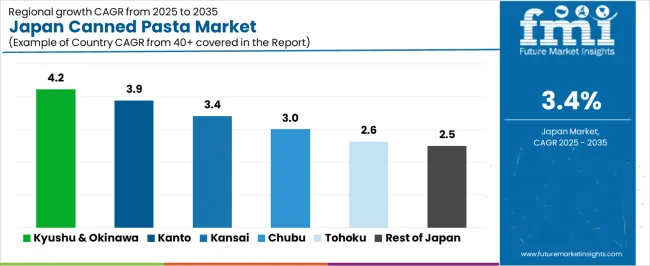
| Region | CAGR (2025-2035) |
|---|---|
| Kyushu & Okinawa | 4.2% |
| Kanto | 3.9% |
| Kansai | 3.4% |
| Chubu | 3.0% |
| Tohoku | 2.6% |
| Rest of Japan | 2.5% |
Kyushu & Okinawa grows at 4.2% CAGR, supported by consistent demand for ready-to-eat meals, strong convenience-store penetration, and steady tourism-linked consumption. Households in Fukuoka, Kumamoto, and Kagoshima frequently purchase canned pasta as part of routine pantry supplies and emergency stockpiling. Okinawa’s tourism sector drives additional demand in hotels, small shops, and retail outlets that supply quick meal options for short-stay travelers. Distribution networks ensure regular availability across urban and semi-urban areas, encouraging repeat purchases. Local food-service operators use canned pasta for cost-controlled menu options, especially in small cafés and institutional settings.
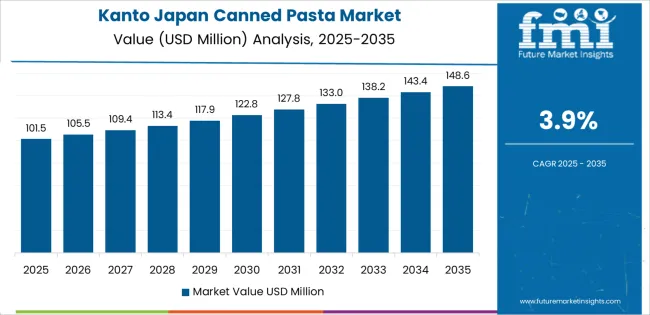
Kanto grows at 3.9% CAGR, driven by dense urban populations, high convenience-store turnover, and strong reliance on quick-meal formats in Tokyo, Kanagawa, Saitama, and Chiba. Canned pasta is purchased by office workers seeking fast meals and households looking for low-effort pantry options. Retail networks across Tokyo maintain high shelf rotation, ensuring wide product availability. Disaster-preparedness practices in the region also contribute to regular stocking of canned meals. Food manufacturers distribute diversified canned pasta varieties suited to urban taste preferences, supporting consistent uptake across supermarkets, drugstores, and convenience chains.
Kansai grows at a 3.4% CAGR, driven by strong food retail activity in Osaka, Kyoto, and Kobe and stable household demand for shelf-stable products. Canned pasta is used by consumers seeking fast meals and by students in densely populated university districts. Retailers maintain consistent product availability across supermarkets and convenience chains. Disaster-preparedness culture in the region supports regular stocking of canned meals in homes and institutional facilities. Food distributors supply multiple pasta varieties, and small food-service operators occasionally use canned options for limited-prep menu items.
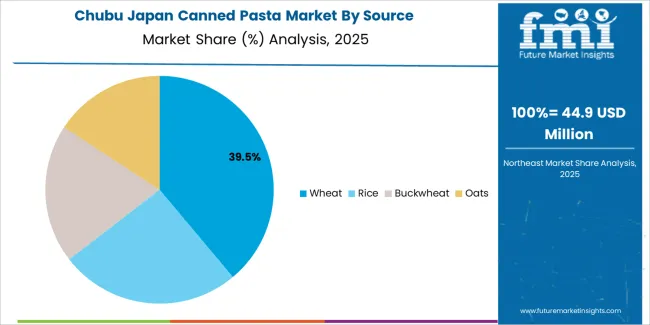
Chubu grows at 3.0% CAGR, supported by mixed urban-rural populations, broad supermarket networks, and moderate reliance on shelf-stable meal products across Nagoya, Shizuoka, and surrounding prefectures. Households purchase canned pasta for convenience and emergency storage. Retailers maintain steady stocking levels, with supermarkets and drugstores serving as primary distribution points. Manufacturing and logistics hubs in Aichi and Shizuoka support efficient distribution, keeping products available across regional cities and towns. Institutional facilities such as dormitories and small workplaces also use canned meals for ease of storage.
Tohoku grows at 2.6% CAGR, driven by household reliance on non-perishable foods, regional preparedness needs, and consistent supermarket distribution across Sendai and nearby prefectures. Consumers purchase canned pasta for convenience and long-term storage. Retailers maintain moderate turnover as demand remains steady but less urban-driven than in Kanto or Kansai. Cold-weather seasons reinforce interest in shelf-stable products that provide easy meal solutions. Local institutions, including community centers and emergency facilities, maintain canned-meal stockpiles.
Rest of Japan grows at 2.5% CAGR, shaped by smaller population centers, moderate retail activity, and regular household purchases of shelf-stable meals. Supermarkets and local stores offer limited but consistent varieties of canned pasta. Households maintain canned products for convenience and emergency storage. Distribution networks ensure periodic restocking across rural and coastal areas. Small institutions such as care homes and community facilities also use canned pasta for low-maintenance meal planning.
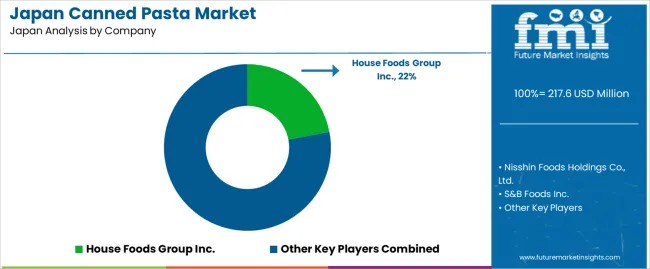
Demand for canned-pasta equivalents in Japan is shaped by domestic food manufacturers that supply retort-pouch pasta meals and shelf-stable sauces, which serve the same functional role as canned pasta in Western countries. House Foods Group Inc. holds an estimated 22.0% share, supported by controlled retort processing, consistent flavour stability, and nationwide distribution across supermarkets and convenience stores. Its ready-to-eat pasta meals offer predictable texture and reliable shelf life, reinforcing steady consumer adoption.
Nisshin Foods Holdings Co., Ltd. maintains strong participation with shelf-stable pasta sauces and ambient pasta meals used in quick-meal occasions. Its formulations provide stable consistency and reliable performance when paired with dried pasta or ready-to-heat meals. S&B Foods Inc. contributes significant volume with ambient sauces and ready-meal bases that provide controlled seasoning, predictable heating behaviour, and broad retail availability.
Kokubu Group Corp. supports the import channel by distributing limited quantities of foreign canned pasta and Western shelf-stable meals. Its role focuses on niche demand for imported products in specialty and wholesale outlets. Costco Wholesale Japan adds additional import volume through private-label and branded canned pasta sourced from Western manufacturers, supplying bulk-purchase consumers and institutional buyers.
Competition in Japan centers on flavour stability, texture reliability after heating, supply continuity, packaging durability, and convenience-focused product formats. Demand remains steady as consumers favour retort-pouch pasta meals and ambient sauces that deliver predictable taste, long shelf life, and easy preparation within Japan’s fast-meal and convenience-driven consumption patterns.
| Items | Values |
|---|---|
| Quantitative Units | USD million |
| Product Type | Spaghetti, Penne & Ziti, Rotini & Twists, Elbows, Fettuccine/Linguine |
| Source | Wheat, Rice, Buckwheat, Oats |
| Distribution Channel | Hypermarkets/Supermarkets, Online Retail Stores, Convenience Stores, Traditional Grocery Stores, Departmental Stores |
| Regions Covered | Kyushu & Okinawa, Kanto, Kansai, Chubu, Tohoku, Rest of Japan |
| Key Companies Profiled | House Foods Group Inc., Nisshin Foods Holdings Co., Ltd., S&B Foods Inc., Kokubu Group Corp., Costco Wholesale Japan / Private-Label Imports |
| Additional Attributes | Dollar sales by product type, grain source, and distribution channel; regional consumption patterns across Kyushu & Okinawa, Kanto, Kansai, Chubu, Tohoku, and Rest of Japan; trends in ready-to-eat pasta meals, shelf-stable convenience foods, and private-label canned pasta; influence of Western cuisine adoption, emergency food stockpiling, and retail pack-size preferences; competitive landscape involving domestic food manufacturers and imported private-label offerings. |
The demand for canned pasta in Japan is estimated to be valued at USD 217.6 million in 2025.
The market size for the canned pasta in Japan is projected to reach USD 303.2 million by 2035.
The demand for canned pasta in Japan is expected to grow at a 3.4% CAGR between 2025 and 2035.
The key product types in canned pasta in Japan are spaghetti, penne & ziti, rotini & twists, elbows and fettuccine/linguine.
In terms of source, wheat segment is expected to command 38.0% share in the canned pasta in Japan in 2025.






Our Research Products

The "Full Research Suite" delivers actionable market intel, deep dives on markets or technologies, so clients act faster, cut risk, and unlock growth.

The Leaderboard benchmarks and ranks top vendors, classifying them as Established Leaders, Leading Challengers, or Disruptors & Challengers.

Locates where complements amplify value and substitutes erode it, forecasting net impact by horizon

We deliver granular, decision-grade intel: market sizing, 5-year forecasts, pricing, adoption, usage, revenue, and operational KPIs—plus competitor tracking, regulation, and value chains—across 60 countries broadly.

Spot the shifts before they hit your P&L. We track inflection points, adoption curves, pricing moves, and ecosystem plays to show where demand is heading, why it is changing, and what to do next across high-growth markets and disruptive tech

Real-time reads of user behavior. We track shifting priorities, perceptions of today’s and next-gen services, and provider experience, then pace how fast tech moves from trial to adoption, blending buyer, consumer, and channel inputs with social signals (#WhySwitch, #UX).

Partner with our analyst team to build a custom report designed around your business priorities. From analysing market trends to assessing competitors or crafting bespoke datasets, we tailor insights to your needs.
Supplier Intelligence
Discovery & Profiling
Capacity & Footprint
Performance & Risk
Compliance & Governance
Commercial Readiness
Who Supplies Whom
Scorecards & Shortlists
Playbooks & Docs
Category Intelligence
Definition & Scope
Demand & Use Cases
Cost Drivers
Market Structure
Supply Chain Map
Trade & Policy
Operating Norms
Deliverables
Buyer Intelligence
Account Basics
Spend & Scope
Procurement Model
Vendor Requirements
Terms & Policies
Entry Strategy
Pain Points & Triggers
Outputs
Pricing Analysis
Benchmarks
Trends
Should-Cost
Indexation
Landed Cost
Commercial Terms
Deliverables
Brand Analysis
Positioning & Value Prop
Share & Presence
Customer Evidence
Go-to-Market
Digital & Reputation
Compliance & Trust
KPIs & Gaps
Outputs
Full Research Suite comprises of:
Market outlook & trends analysis
Interviews & case studies
Strategic recommendations
Vendor profiles & capabilities analysis
5-year forecasts
8 regions and 60+ country-level data splits
Market segment data splits
12 months of continuous data updates
DELIVERED AS:
PDF EXCEL ONLINE
Canned Pasta Market Trends - Convenience & Consumer Preferences 2025 to 2035
Demand for Canned Meat in Japan Size and Share Forecast Outlook 2025 to 2035
Demand for Canned Legumes in Japan Size and Share Forecast Outlook 2025 to 2035
Japan Faith-based Tourism Market Size and Share Forecast Outlook 2025 to 2035
Japan Sports Tourism Market Size and Share Forecast Outlook 2025 to 2035
Canned Wet Cat Food Market Size and Share Forecast Outlook 2025 to 2035
Japan Respiratory Inhaler Devices Market Size and Share Forecast Outlook 2025 to 2035
Japan Halal Tourism Market Size and Share Forecast Outlook 2025 to 2035
Canned Food Packaging Market Size and Share Forecast Outlook 2025 to 2035
Canned Wine Market Size and Share Forecast Outlook 2025 to 2035
Canned Pet Food Market Analysis - Size and Share Forecast Outlook 2025 to 2035
Japan Automated People Mover Industry Size and Share Forecast Outlook 2025 to 2035
Japan Automotive Load Floor Industry Analysis Size and Share Forecast Outlook 2025 to 2035
Canned Food Packaging Industry Analysis in the United Kingdom Size and Share Forecast Outlook 2025 to 2035
Japan Food Cling Film Market Size and Share Forecast Outlook 2025 to 2035
Pasta Sauces Market Size and Share Forecast Outlook 2025 to 2035
Japan Polypropylene Packaging Films Market Size and Share Forecast Outlook 2025 to 2035
Pasta Machine Market Size and Share Forecast Outlook 2025 to 2035
Canned Fruits Market Size and Share Forecast Outlook 2025 to 2035
Overview of Key Trends Shaping Canned Tuna Business Landscape.

Thank you!
You will receive an email from our Business Development Manager. Please be sure to check your SPAM/JUNK folder too.
Chat With
MaRIA